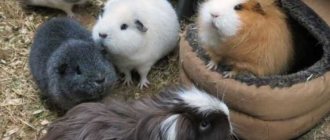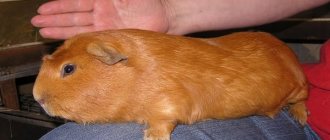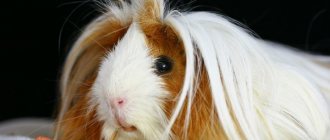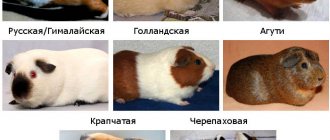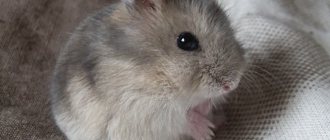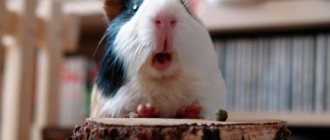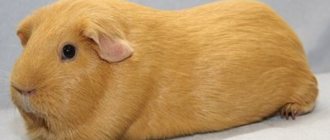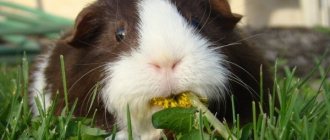Review author: “ZooVita”
Sooner or later, every person faces the choice of a pet. And after cats and dogs, some of the first animals that come to mind are all kinds of rodents.
A special place among them is occupied by the domestic guinea pig. These cute and friendly animals get along well with people, are devoid of aggression, are very clean and are considered long-lived among their own kind.
History and origin
Guinea pigs were brought to Europe in the 18th century from America. They were domesticated and kept as ornamental pets. In their homeland in South America, guinea pigs live in entire colonies of 20-25 individuals. Each colony has its own leader, who protects his possessions and the flock.
Cleaning ears and eyes
This is an important step in caring for a smooth-haired guinea pig. Clean them regularly using a regular cotton swab, which must be moistened in an aqueous solution of Chlorhexidine. If there are crusts in the ears, a special “Bars” solution is instilled into them. If the animal squeals when performing this manipulation, then it is advisable to visit a veterinarian, since the cause of this behavior may be ear mites.
Crusts periodically form in the corners of the eyes; they can be easily removed with a cotton pad moistened with warm water or tea leaves. If you notice redness or watery eyes, then most likely a foreign body has entered the eye. In such cases, the help of a veterinarian is required.
Guinea pig breeds and colors
While rats and hamsters are all the same, the variety of breeds of these rodents is simply mind-boggling. You can spend the whole day looking at photos of guinea pigs. And these will be only the most famous and common ones!
The American pig is the most common and oldest variety on the market. The coat of this breed is short, smooth and shiny. It fits tightly to the rodent's body and can have a completely different colors.
The Abyssinian breed is famous for its rosettes all over its body. The fur on the animal's skin is wrapped in a circle and forms a vortex. The number of such sockets can reach 6-10 pieces.
They are located chaotically throughout the body, with the exception of the head and abdomen of the animal. The coat color can be either monochromatic or combine several colors at once: white, black, red.
The Peruvian pig deserves special attention. Representatives of this breed boast silky and record-long hair. In some individuals, the hair length reaches 50 cm. Another feature of this breed is that the hair grows from the sacrum to the head and hangs over the eyes.
Cornet and Sheltie are also long-haired breeds. It is noteworthy that babies are born with short fur, and only at three months does it begin to grow back. The coat grows from the face to the tail and can lengthen by 2.5 cm every month. It is recommended to periodically trim the pigs to avoid tangles.
But among the pigs there are also completely bald representatives. The skinny guinea pig is easily recognizable due to its complete lack of hair. Only on the face and paws there are small areas with sparse hair. The skin of these rodents is very soft and pleasant to the touch.
These are not all breeds of guinea pigs. The selection process can be long and painful, because they are all beautiful and unique in their own way.
Rare breeds
Among the varieties that have not yet become widespread, there are also white individuals.
Kui guinea pig
A giant rodent weighing up to 4 kg. Cui pigs live in South America and are not considered ornamental animals there. They are bred by local residents along with llamas and alpacas.
Cavies of this breed often have dewclaws. But polydactyly does not affect the animal’s life in any way. The Kui guinea pig can be a solid white color. But representatives of the breed are also characterized by other colors.
California
The breed has not yet received official recognition. This means that there is no single standard either. California guinea pigs are covered with smooth, short hair. And their fur has a color-point color. There are dark markings on a mostly flawless white, cream, gold, saffron or red background.
The points are localized on the ears, nose and feet of the animal. And around the eyes of the Californian guinea pig there are characteristic dark “glasses”. The points are chocolate, black, beige or purple, the eyes are dark or red.
Ridgeback (Rhodesian)
These animals appeared relatively recently and are easily recognizable by the low crest located on their back. Due to this feature, Ridgebacks always have an aggressive appearance. Representatives of the breed are characterized by different color options, including immaculate white.
Himalayan
Cavey of this breed has red eyes. Due to this feature, the animal is considered a partial albino. The body of the Himalayan guinea pig is immaculately white with black or brown markings located around the eyes, nose, ears and paws of the animal.
Curley
A short-haired animal with curly fur and well-defined whiskers. According to the standard, a Curly guinea pig can have not only a pure white color, but also any other single or combined color.
Lunkaria
A beautiful exotic animal with uneven curly fur. The lunkaria guinea pig is completely covered with hair. Only the muzzle remains ungrown. Lunkaria fur can be not only perfectly white, but also almost any other color.
Decorative caves with a perfectly white coat and shiny beady eyes immediately attract attention with their fragile and delicate appearance. However, behind the external vulnerability of rodents lies a playful and friendly disposition. Therefore, charming and cute animals are able to conquer even the harshest hearts and quickly turn into favorites of adults and children.
Guinea pig lifespan
Another reason to choose a guinea pig as a pet is its relatively long lifespan. On average, representatives of this class can live 6-8 years in captivity. While hamsters live 1-2 years, and rats - 3-4 years.
Belonging to one breed or another plays an important role in the race for life. Representatives of short-haired breeds can live up to 8 years. Long-haired beauties live on average 5-6 years, just like rosette Abyssinians. But hairless guinea pigs can live only 5 years due to weak immunity.
The absence of genetic diseases and simple care makes smooth-haired breeds long-lived among other breeds.
Please note ⭐⭐⭐
Domestic duck: varieties and rules for caring for them, how to breed ducks at home
Domestic hedgehog: rules for keeping it at home, tips for choosing an animal (120 photos)
Domestic ferret (ferret): features of keeping and caring for the animal, standards, types of breeds, what they eat, how long they live (photo)
But the main and decisive factor influencing life expectancy is the living conditions of guinea pigs.
Skin care and manicure
The smooth-haired guinea pig, a photo of which is in the article, requires brushing its coat every three to four days. A brush with soft natural bristles is suitable for these purposes. With this simple procedure, dead hair is removed and new hair growth is activated. Brushing is a pleasure for your pet.
Long claws cause a lot of trouble, as they cause bacterial infections and problems with the musculoskeletal system. They are cut with a special tool once every six months. This must be done very carefully so as not to damage the vessels and nerves that are located at the base of the claw.
Features of keeping at home
These animals need a spacious cage that will be adapted to their lifestyle. The ideal option would be a one-story cage 130-150 cm in length. Definitely a cage, and not an aquarium or terrarium, because... In a glass box, an animal can overheat and die.
The cage can additionally be equipped with a wooden house, tunnels, bridges and all kinds of beds and hammocks. It is important that all materials are natural.
Sawdust or special wood pellets are usually used as bedding. They absorb moisture perfectly. In addition, rodents willingly grind granules, grinding down their teeth in the process.
The filler must be laid in a layer of at least 5 cm and changed as it gets dirty, but at least once a week. Pigs are very clean and go to the toilet in the same place.
The cage with the pet must be installed in a place where there are no drafts or open sunlight, because... it is harmful to the health of rodents. It will also be good if the pig can see its owner, so that the animal does not grow up wild and timid.
Please note ⭐⭐⭐
Domestic horse: description of breeds, types, features of maintenance and care, colors, what they eat, how long they live (140 photos)
- Domestic goat: breeds with names, rules of care and breeding at home, many photos and features of an unpretentious animal
Domestic pig: description of how to keep and care for it at home. Breeds, sizes, what they eat, habits (115 photos)
Why do hamsters fight?
Discussion: there is 1 comment
- vetpPaype:
10/29/2018 at 10:04 pmAs Antoine de Saint-Exupéry bequeathed, we are responsible for those we have tamed. All our pets provide loyalty, relaxation and joy from communication, but at the same time they represent a great responsibility. Pets require equal attention and good care. Therefore, absolutely any attentive owner always knows where, if necessary, he can buy veterinary drugs for his pet today. Veterinary drugs are not only medicines for diseases, to which, unfortunately, all representatives of the animal world are susceptible. Your beloved pet needs constant care, and above all, the prevention of various diseases. You will need anti-parasite medications, vitamin complexes, eye and ear drops, and vaccinations.
Answer
Nutrition
The lifespan of rodents also directly depends on what guinea pigs eat. The basis of the daily diet is hay, and in the summer - grass. It should be in the cage constantly and regularly replaced with a new one.
In addition, it is worth diluting the diet with fresh vegetables, fruits and seeds. You can also pamper your pet with dried plant roots and a twig from a tree. Do not give dried fruits, confectionery, flour, cereals, radishes, potatoes, legumes, peaches, bananas and citrus fruits.
The water bowl should also always be filled. The automatic drinking bowl is placed at muzzle level to make the animal comfortable. Or use a ceramic bowl, which will be heavy and stable.
Teddy
These short-haired guinea pigs were bred in the 60s of the 20th century in Canada. These animals resemble teddy bears, which is why they have become very popular.
Teddies have a straight, thick coat that makes them reminiscent of a Rex, and the two varieties can sometimes be difficult to tell apart. But a careful look will notice that the teddy’s fur is stiffer, thicker, and the protruding hairs on the face resemble needles. But sometimes animals with softer fur appear.
Disadvantages: elongated body, coat longer than 2 cm or sloping.
In the photo: short-haired guinea pig Teddy
Health
Guinea pigs are not known for their Siberian health. Infectious diseases are almost always fatal. The consequence of a draft can be pneumonia, and direct sunlight can lead to heat stroke.
You should also carefully monitor your diet and avoid foods that can lead to fermentation and bloating.
Another factor that can greatly affect your pet’s well-being is the lack of company. Guinea pigs live in colonies and cannot stand being alone. They can literally die of boredom.
Please note ⭐⭐⭐
Domestic rabbits: breeding, care rules, description of breeds + 110 photos
- Chickens at home: care rules, breeding instructions, overview of breeds and species with photos and names
- Chinchilla: features of keeping at home, colors, photos, character, how long they live, what they eat, how to care for them, interesting facts
To keep your pet happy, you need to buy at least a couple of rodents. Same-sex is possible if there is no goal of breeding.
Water treatments
They are necessary in rare cases when the pig is very dirty. The rest of the time she cleans her fur on her own. For water procedures you need to prepare:
- small terry towel;
- special shampoo;
- container with anti-slip coating.
The water temperature should not exceed 38 degrees. During this manipulation, you must carefully ensure that water does not get into the animal’s ears. After completing the bath, he is wrapped in a towel.
Reproduction and offspring
When a pair of guinea pigs live in a cage, the offspring will not be long in coming. A female can give birth to up to two litters in a year. Each pregnancy lasts about 70 days and brings 4-6 babies.
During pregnancy, the male should be removed. After birth, the female feeds the offspring with milk for a whole month, after which the babies become ready for independent life and should also be separated.
A guinea pig can become a wonderful pet - a favorite of children and adults. If you provide the animal with decent care, it will delight the whole family for many years.
Description of the animal
The homeland of the guinea pig is South America. Those who lived there in the 5th millennium BC. e. Indian tribes were engaged in breeding these cute rodents. They domesticated animals to eat their meat. Animals were also sacrificed to the gods. After Columbus discovered America, animals came to the European continent.
The guinea pig does not live in water and does not like to swim, although if necessary it can swim across a small stream. It received this name because it was brought by ship by sea, and in appearance it somewhat resembles a pig.
Currently, residents of South America also use guinea pigs as a source of dietary meat. It is similar in taste and nutritional value to chicken.
Guinea pigs are rodents that belong to the pig family. In their natural environment, animals are found in mountainous areas, forests and dense forest edges. They form groups of 10-14 individuals and settle where there is a lot of plant food.
The life of guinea pigs in the wild is full of surprises - they constantly have to fight for survival, so the animals are distinguished by their agility and endurance. They easily climb rocky slopes and tree trunks when fleeing from enemy pursuit.
Wild guinea pigs are slightly smaller than their domesticated cousins. Rodents have a strong skeleton and well-developed muscles. Their fur is colored brown. Thanks to this color, it is easier for them to hide among the stones.
Unlike most representatives of the rodent order, wild guinea pigs do not live in burrows. They use rock crevices and tree hollows as homes. To furnish their “home,” rodents use available materials—dry grass, branches, and fluff.
During the daytime, the guinea pig hides in a shelter, and at dusk comes out in search of food. Pets can be active at any time of the day.
Appearance
Those who carefully studied the description of the guinea pig noticed how unique the structure of its body is. It does not look like rabbits or chinchillas, and even more so has significant external differences from rats and hamsters.
What does a guinea pig look like:
- the body is cylindrical, well-built, with well-developed muscle mass;
- the head is quite large;
- wide blunt muzzle;
- eyes are round in shape, reminiscent of beads;
- ears are medium-sized, drooping, with wavy tips;
- the neck is so short that it is practically invisible;
- limbs of short length;
- there are 4 toes on the front paws, 3 on the hind paws;
- the tail is missing.
The coat can vary in length, texture and color depending on the breed of guinea pig. The cover can be long or short. There are also hairless varieties.
Breeders managed to breed rodents with smooth, hard and even curly hair.
Dimensions and weight of the rodent
The guinea pig grows to a size of about 24-35 cm in length. The height at the withers is 5-7 cm. The dimensions of the animal largely depend on the breed and gender - females are slightly smaller than males.
A guinea pig weighs 700-1500 g. The size of an adult male varies between 22-35 cm, and body weight - 1-1.8 kg. Animals develop most actively until they are one year old, but continue to grow for several more months.
A guinea pig reaches its maximum size when it is 1.5 years old. Then its growth stops.
Characteristics and structure of a guinea pig
Anyone who sets out to learn everything about guinea pigs should also get acquainted with the structural features of their internal organs:
- Oral cavity. The incisors of these animals grow throughout their lives. There are no fangs, and the lower jaw can move in different directions. To grind down teeth, solid food is introduced into the pet's diet.
- Limbs. Guinea pigs' paws resemble miniature hooves. The claws on the fingers grow quickly. Therefore, they need to be trimmed in a timely manner. Neglecting this recommendation leads to deformation and curling of the claws.
- Digestive system. In guinea pigs, the total length of the intestines exceeds the length of the body by 2.5-3 times. The process of digesting food takes 5 or more days. Prolonged fasting is dangerous for the life of a rodent, since food moves further through the intestines only after the arrival of a new portion.
- The cardiovascular system. The heart of a guinea pig weighs 2-2.5 g. The tiny “motor” makes 350 beats per minute.
- Mammary gland. Few people know that the female has only one pair of nipples.
- Fecal pocket. Male guinea pigs have a small fold-like formation in the anal area. It contains glands that produce a secretion with a pungent odor. With its help, males attract females.
Character and habits
Decorative guinea pigs are friendly animals without a hint of aggression. They quickly get used to their owner and become tamed. The rodent likes to be picked up and stroked.
Many pets eagerly await their owners' return from work - they rise on their hind legs and peek out. At the same time, pigs make a variety of sounds. They resemble water gurgling, chirping and purring. When an animal is afraid, it squeaks shrilly.
Guinea pigs are very clean. In nature, this trait helps them remain unnoticed by the enemy. They love to clean and lick themselves and willingly help their neighbors with this.
Guinea pigs are quite smart animals. They remember the owner's voice and respond to it. Some rodents respond to their name.
Health and life expectancy
In its natural environment, a guinea pig can live 1-4 years. There, the animal can become prey for wild animals and large birds every day. In addition, there is a chance of contracting a contagious disease and dying.
At home, a rodent can live twice as long - about 8 years. Some individuals manage to cross the ten-year threshold. The long-living record holder delighted his owners for almost 15 years.
The most common rodent diseases:
- Dental problems. Due to the lack of solid food, the incisors do not have time to grind down and become too long. This leads to damage to the soft tissues of the oral cavity, drooling and other troubles.
- Injuries. The greatest danger comes from falling even from a small height. A pig can break its spine or leg.
- Avitaminosis. Guinea pigs do not produce vitamin C; they must get it from their food. With its deficiency, the animal’s immunity weakens, bald spots appear on the body, and the gums begin to bleed.
- Colds, bronchitis, pneumonia due to hypothermia. The first sign of illness is a runny nose. If left untreated, the cold will turn into bronchitis, and then into pneumonia.
- Conjunctivitis. This is an inflammation of the mucous membrane of the eye, in which there is redness of the eyelids, tearing and purulent discharge. The main causes of the disease are viral or bacterial infection and allergies.
- Diarrhea. If your guinea pig develops diarrhea, you should see a doctor immediately. Loose stools can be one of the symptoms of a deadly infectious disease.
- Tumors. Benign and malignant neoplasms are common in rodents. They affect the lungs, lymph nodes, mammary glands and skin.
Important! The animal will live a long time if you carefully monitor its condition every day. Any alarming symptoms, such as lethargy, loss of appetite, snot, wheezing, should be a reason to visit the veterinarian.
